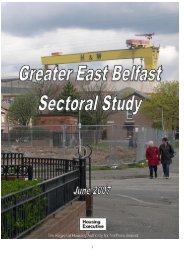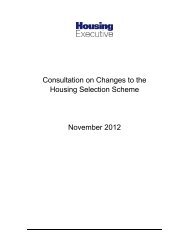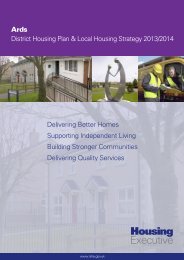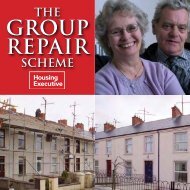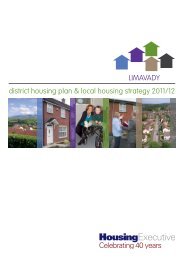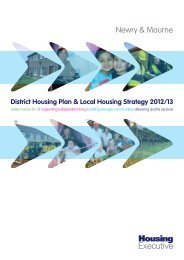"More than bricks" ( 5882 KB) - Northern Ireland Housing Executive
"More than bricks" ( 5882 KB) - Northern Ireland Housing Executive
"More than bricks" ( 5882 KB) - Northern Ireland Housing Executive
You also want an ePaper? Increase the reach of your titles
YUMPU automatically turns print PDFs into web optimized ePapers that Google loves.
MoRE thAn BRicKS<br />
40 YEARS of thE houSing ExEcutivE
contEntS<br />
<strong>More</strong> <strong>than</strong> bricks 3<br />
Foundations for change 9<br />
Making a start 17<br />
A divided community 29<br />
Progress through innovation 45<br />
Leading the way 59<br />
New responsibilities and challenges 67<br />
Improvements, Churchhill Park, Portadown, June 1999<br />
1
MoRE thAn BRicKS<br />
Kids on the move, Belfast, June 1974<br />
Country cottage, 1974<br />
3
2011 marks the 40th anniversary of the <strong>Housing</strong><br />
<strong>Executive</strong>, an organisation which has a proud history<br />
of achievement and progress.<br />
Since its formation in 1971 the <strong>Housing</strong> <strong>Executive</strong><br />
has built many houses, sold tens of thousands of<br />
homes to tenants, carried out countless repairs<br />
and improvements to its stock, provided thousands<br />
of improvement grants for private households and<br />
demolished unfit dwellings.<br />
When you work in housing, however, you quickly<br />
learn that the job is more <strong>than</strong> bricks. When you<br />
work in housing you deal with people, families and<br />
communities.<br />
At the forefront of all that we have achieved has<br />
been the delivery of decent homes for the people of<br />
<strong>Northern</strong> <strong>Ireland</strong>. Our vision has been one in which<br />
housing plays its part in making a vital contribution to<br />
creating a peaceful, inclusive and fair society.<br />
While one of our constant challenges has been<br />
working against the backdrop of community division,<br />
the organisation has worked through recessions and<br />
the recent rapid growth in the housing market and its<br />
sudden collapse in 2008. This is a testament to the<br />
quality of our staff and their professional approach to<br />
housing.<br />
Brian Rowntree<br />
Chairman<br />
John McPeake<br />
Chief <strong>Executive</strong><br />
Doon Park, Carryduff, May 2000<br />
Moyard, Belfast circa 1973<br />
5
This book, published to mark the 40th anniversary<br />
of the <strong>Housing</strong> <strong>Executive</strong>, tells the story of how in its<br />
history, it has improved the lives of many people in<br />
<strong>Northern</strong> <strong>Ireland</strong>, through some of our darkest days.<br />
It shows the positive impact that investment in<br />
housing has had. Throughout the years we have had<br />
tremendous support from our Ministers and colleagues<br />
in our sponsoring/parent government departments,<br />
now the Department for Social Development.<br />
Our work with others, those in the housing association<br />
movement, the <strong>Housing</strong> Council, local government and<br />
other government departments, tenant and community<br />
groups, public representatives, political parties and<br />
others in the voluntary sector has been very important<br />
in tackling housing issues and developing stronger<br />
communities.<br />
Donegall Road, Belfast,<br />
August 1981<br />
Country cottage kitchen, circa<br />
1973<br />
Brian Rowntree<br />
Chairman<br />
Dr John McPeake<br />
Chief <strong>Executive</strong><br />
7
foundAtionS foR chAngE<br />
View of Belfast from Cave Hill<br />
‘Hands across the Divide’ statue, Derry/Londonderry<br />
9
10<br />
Pictures courtesy of the Belfast Telegraph
The late 1960s was not all about the Beatles, Flower<br />
Power and Neil Armstrong walking on the moon. It<br />
was also a time of upheaval and protest at home<br />
and abroad. The United States was caught up in an<br />
unpopular war in Vietnam and students were fighting<br />
pitched battles with police on the streets of Paris. Here<br />
in <strong>Northern</strong> <strong>Ireland</strong>, students also took to the streets.<br />
They demanded the reform of local government.<br />
The Civil Rights Association, formed in 1967,<br />
highlighted poor housing conditions and dissatisfaction<br />
with housing administration. In 1968 one Stormont MP<br />
occupied a council house at Caledon, County Tyrone,<br />
to demonstrate the inconsistencies and unfairness in<br />
the allocation of houses.<br />
Protests and disorder led to ever increasing violence.<br />
The summer of 1969 witnessed riots across <strong>Northern</strong><br />
<strong>Ireland</strong> and in August of that year, the first troops<br />
appeared on the streets.<br />
The civil disturbances of the late 1960s marked the<br />
beginning of ‘The Troubles’. It was the beginning of<br />
a long dark era, but also the beginning of reform.<br />
<strong>Housing</strong> would be central to this.<br />
The reform of housing administration in <strong>Northern</strong><br />
<strong>Ireland</strong> began in the autumn of 1969 after discussions<br />
at government level laid the foundation for an overhaul<br />
of public services. These changes would radically<br />
affect the administration of housing and other key<br />
public services.<br />
11
On 25 February 1971, new legislation introduced<br />
to <strong>Northern</strong> <strong>Ireland</strong> formed a watershed in the<br />
administration of housing. The legislation, the <strong>Housing</strong><br />
<strong>Executive</strong> Act (<strong>Northern</strong> <strong>Ireland</strong>), created the embryo<br />
for a new authority which was charged with addressing<br />
long-standing concerns about the allocation of housing<br />
and the poor housing conditions. Four decades later<br />
the <strong>Housing</strong> <strong>Executive</strong> remains the comprehensive<br />
housing authority for <strong>Northern</strong> <strong>Ireland</strong>.<br />
The new legislation allowed for the transfer to the<br />
<strong>Housing</strong> <strong>Executive</strong> of all the housing functions -<br />
and their dwellings - previously held by 65 local<br />
government authorities and development agencies.<br />
Over a short period, the <strong>Housing</strong> <strong>Executive</strong> was to<br />
become owner of 150,000 homes.<br />
The new authority was led by a Board, headed by<br />
an appointed Chairman. Day-to-day management<br />
became the responsibility of a Director General.<br />
While the new legislation removed housing from local<br />
political control, public representatives would advise<br />
the <strong>Housing</strong> <strong>Executive</strong> through a new consultative<br />
forum - the <strong>Northern</strong> <strong>Ireland</strong> <strong>Housing</strong> Council. The<br />
<strong>Northern</strong> <strong>Ireland</strong> <strong>Housing</strong> Council has worked with the<br />
<strong>Housing</strong> <strong>Executive</strong>, advising and consulting on a whole<br />
range of housing issues and policies. Its members,<br />
from each of the District Councils, have shared their<br />
expertise in the development of housing policies which<br />
have and are making a difference to the lives of people<br />
in <strong>Northern</strong> <strong>Ireland</strong>.<br />
Old housing, Roden Street,<br />
Belfast 1974<br />
The first Board of the<br />
<strong>Northern</strong> <strong>Ireland</strong> <strong>Housing</strong><br />
<strong>Executive</strong>, 1971<br />
The <strong>Housing</strong> Act (<strong>Northern</strong><br />
<strong>Ireland</strong>) 1971<br />
13
The most important feature of the 1971 legislation<br />
was the comprehensive powers which it gave to the<br />
<strong>Housing</strong> <strong>Executive</strong>. The new authority was to assist<br />
both the public and private housing sectors. The major<br />
tasks given to the <strong>Housing</strong> <strong>Executive</strong> at its inception<br />
were:<br />
• Building new homes<br />
• Managing and maintaining existing housing estates<br />
• Helping the private housing sector<br />
• Measuring housing conditions<br />
• Undertaking housing research<br />
• Providing housing advice and information<br />
At the first meeting in May 1971, members were<br />
warned by the <strong>Housing</strong> Minister that they faced a long<br />
and difficult task.<br />
Cottage kitchen with a cold<br />
water supply, Fermanagh,<br />
May 1975<br />
<strong>Housing</strong> Actions Area, New<br />
Lodge, Belfast, August 1975<br />
Terraced housing,<br />
Beersbridge Road, Belfast,<br />
June 1973<br />
15
MAKing A StARt<br />
Castle Street, Armagh, June 1974 and 1987<br />
17
In 1973, the <strong>Housing</strong> <strong>Executive</strong> took over the last<br />
homes from <strong>Northern</strong> <strong>Ireland</strong>’s local authorities and<br />
then set about quantifying the scale of the housing<br />
problem.<br />
The first House Condition Survey in 1974 painted a<br />
bleak picture. The survey found that almost 20% of all<br />
homes in <strong>Northern</strong> <strong>Ireland</strong> were unfit for occupation. In<br />
Belfast, the situation was even worse and around 25%<br />
required either demolition or major renovation.<br />
<strong>Northern</strong> <strong>Ireland</strong> was found to have the worst housing<br />
conditions in Britain and amongst the worst in Europe.<br />
The small, cramped, Victorian and Edwardian homes<br />
which had characterised much of Belfast and many<br />
provincial towns had left a legacy of wholly inadequate<br />
accommodation, with large numbers in serious decay<br />
and dereliction.<br />
A housing crisis on such a scale clearly needed a<br />
major response. A full scale offensive was required,<br />
spearheaded by a massive new house building<br />
programme.<br />
The <strong>Housing</strong> <strong>Executive</strong> immediately embarked upon a<br />
new house building programme. By the end of 1974,<br />
a house building programme of unsurpassed scale<br />
had swung into action, which in 1975, involved work<br />
starting on over 6,000 homes. By 1996 the <strong>Housing</strong><br />
<strong>Executive</strong> had built over 80,000 homes across<br />
<strong>Northern</strong> <strong>Ireland</strong>.<br />
Scale was important, but so too was quality. High and<br />
medium rise housing had characterised the 1960s,<br />
leading to much dissatisfaction, but now the <strong>Housing</strong><br />
<strong>Executive</strong> saw to it that quality family homes would be<br />
synonymous with this new era.<br />
The first House Condition<br />
Survey, January 1974<br />
Studying the housing model<br />
Launch of Homesteading,<br />
Belfast 1980<br />
19
The <strong>Housing</strong> <strong>Executive</strong> also turned its attention<br />
to other issues such as redevelopment and the<br />
modernisation of older properties rather <strong>than</strong><br />
replacement. Additionally the introduction in 1976<br />
of a renovation grants scheme allowed the <strong>Housing</strong><br />
<strong>Executive</strong> to extend its services to the private sector.<br />
The introduction of grants was one of the <strong>Housing</strong><br />
<strong>Executive</strong>’s main tools for reducing unfitness in<br />
privately owned housing by providing assistance for<br />
the improvement, repair and adaptation of domestic<br />
properties.<br />
With some 400,000 grants approved, the scheme over<br />
40 years has ensured the continual improvement of<br />
housing standards, reduced unfitness and prevented<br />
homes from becoming unfit through disrepair. It has<br />
also helped vulnerable people live in safe and suitable<br />
accommodation and supported urban and rural<br />
regeneration across <strong>Northern</strong> <strong>Ireland</strong>.<br />
Reconstruction in Farringdon<br />
Gardens in 1973, after a<br />
bomb in 1971<br />
Graffiti at College Square<br />
North, Belfast 1979<br />
Renovations to flats at Derrin<br />
Park, Enniskillen, June 1987<br />
New build at Warrenpoint,<br />
January 1976<br />
21
Civil Engineer, 1974 <br />
Architects, 1975<br />
Quantity Surveyor, 1974<br />
23
The <strong>Housing</strong> <strong>Executive</strong>’s new van livery circa 1974 <br />
Switchboard, 1980<br />
Computer training, 1982<br />
25
Tenants moving home, Markets Area, Belfast, October 1981<br />
Tenants moving home, Short Strand, Belfast, October 1981<br />
Moving in, October 1981<br />
27
28<br />
Picture courtesy of the Belfast Telegraph
A dividEd coMMunitY<br />
Peaceline walls, Cliftonville Road area, Belfast, April 1995<br />
29
30<br />
Picture courtesy of the Belfast Telegraph
The civil disturbances of the late 1960s gave way<br />
to serious violence. Thousands of homes suffered<br />
damage and destruction from rioting and bombing and<br />
families were forced to move in fear from areas torn<br />
apart by civil strife.<br />
In Belfast, 14,000 homes were damaged in 284<br />
bomb explosions in 1972 alone. It was estimated<br />
that between August 1969 and February 1973,<br />
some 60,000 people, 12% of Belfast’s population<br />
were forced to leave their homes. This tragedy was<br />
described at the time as Europe’s largest movement of<br />
population since the end of World War Two.<br />
The disturbances of the early 1970s were to<br />
seriously compound existing housing problems. The<br />
widespread damage to property placed a serious<br />
drain upon housing resources and hampered<br />
progress. Nevertheless, the <strong>Housing</strong> <strong>Executive</strong> acted<br />
quickly to provide emergency accommodation and to<br />
repair damaged homes.<br />
Aftermath of a bomb<br />
explosion<br />
A child at the peaceline<br />
separating Lenadoon Estate,<br />
Belfast, September 1973<br />
Fountain, Londonderry,<br />
September 1973<br />
31
In November 1972, the <strong>Housing</strong> <strong>Executive</strong>’s own<br />
headquarters in Belfast suffered serious damage in a<br />
car-bomb attack.<br />
It is worth recalling the words of Desmond Lorimer, the<br />
first Chairman of the <strong>Housing</strong> <strong>Executive</strong>:<br />
“At times it appears as if our efforts may be crushed<br />
between the upper millstone of civil disorder and<br />
the nether millstone of unrealistic expectations. The<br />
people of this province will solve their problems when<br />
they have a full and realistic appreciation of them and<br />
when they take pride in rebuilding their community. We<br />
will begin to solve the major housing difficulties which<br />
confront us when we face up to the fact that we cannot<br />
afford the dissipation of our energies, our resources<br />
and our finance, which results from civil disturbance,<br />
wanton vandalism and continued violence.”<br />
Bomb damage at<br />
Fortwilliam Parade, Belfast,<br />
February 1976<br />
Bomb damage at the<br />
<strong>Housing</strong> <strong>Executive</strong>’s Lurgan<br />
District Office, March 1992<br />
Bomb damage at the<br />
<strong>Housing</strong> <strong>Executive</strong>’s Carlton<br />
House office, Belfast,<br />
circa 1973<br />
33
In the early days, with law and order under threat, our<br />
rent collectors were robbed on an almost daily basis.<br />
The response was the rapid introduction of new rent<br />
payment systems.<br />
In many areas law and order had broken down<br />
and normal housing management became difficult<br />
as the withholding of rent and squatting became<br />
commonplace. By the beginning of 1973, squatters<br />
occupied over 5,000 <strong>Housing</strong> <strong>Executive</strong> homes.<br />
There remained serious concerns about the methods<br />
used to allocate homes. The <strong>Housing</strong> <strong>Executive</strong> was<br />
eager to resolve this issue. Its credibility rested on<br />
being able to win public confidence through impartiality<br />
and so in 1974, the <strong>Housing</strong> Selection Scheme was<br />
introduced. Although the Selection Scheme has<br />
been revised many times, the principles remain the<br />
same. <strong>Housing</strong> is allocated on the basis of need and<br />
availability. That the Selection Scheme has endured is<br />
clearly a mark of its success.<br />
Peaceline at Adam Street,<br />
Belfast, March 1990<br />
Peaceline walls, Crumlin<br />
Road, Belfast, April 1995<br />
35
The Troubles continued to have a direct impact on<br />
the <strong>Housing</strong> <strong>Executive</strong>’s ability to deliver a housing<br />
service. An increasingly divided community led to<br />
greater segregation, particularly in Belfast. Throughout<br />
the Troubles and beyond into more peaceful times,<br />
communities have remained divided. Peacelines<br />
are the most graphic symbol of this division with 53<br />
officially maintained lines in <strong>Northern</strong> <strong>Ireland</strong>.<br />
Many housing problems have been compounded by<br />
the deep rooted sectarianism that remains a feature<br />
in some parts of <strong>Northern</strong> <strong>Ireland</strong>. Some 90% of<br />
<strong>Housing</strong> <strong>Executive</strong> estates are predominantly single<br />
identity and this rises to 94% in Belfast. The <strong>Housing</strong><br />
<strong>Executive</strong>’s responsibility is to ensure that housing is<br />
provided on the basis of need. Segregation, however,<br />
gets in the way of meeting housing need and prevents<br />
the best use being made of existing housing and land.<br />
Over the years the <strong>Housing</strong> <strong>Executive</strong> has helped<br />
people and communities, responding to intimidation and<br />
property damage, and implementing the SPED (Special<br />
Purchase of Evacuated Dwellings) and the POPPI<br />
(Protection of Private Properties at Interfaces) schemes.<br />
In 2008, the <strong>Housing</strong> <strong>Executive</strong>’s response to helping<br />
1,000 households in the Belvoir area following a bomb<br />
explosion at <strong>Northern</strong> <strong>Ireland</strong>’s Forensic Laboratory<br />
in 1992 was recognised, when Castlereagh Borough<br />
Council conferred the Freedom of the Borough on the<br />
organisation.<br />
Major disruption returned to the streets of <strong>Northern</strong><br />
<strong>Ireland</strong> in 1995 following a dispute over a parade in<br />
Drumcree, Portadown. This violence would recur<br />
every summer over the next few years resulting in<br />
widespread intimidation and many families being<br />
forced to leave their homes.<br />
Bomb damage, Belvoir,<br />
Belfast, September 1992<br />
Kids on an estate help to<br />
clear up, June 1973<br />
Clean-up in the Village area,<br />
Belfast, January 2006<br />
37
The <strong>Northern</strong> <strong>Ireland</strong> Act 1998 gave the <strong>Housing</strong><br />
<strong>Executive</strong> a key role in promoting good community<br />
relations and community cohesion.<br />
Through the <strong>Housing</strong> <strong>Executive</strong>’s local presence<br />
in communities and its longstanding relationship<br />
with community groups, the <strong>Housing</strong> <strong>Executive</strong> has<br />
worked to build good relations through its policies<br />
and initiatives. Initially working with local groups, the<br />
Common Ground Consortium, Habitat for Humanity<br />
and the Mediation Service, the <strong>Housing</strong> <strong>Executive</strong><br />
promoted and supported the clean up of estates<br />
and the removal of the manifestations of division.<br />
The <strong>Housing</strong> <strong>Executive</strong>’s Community Relations<br />
Strategy in 2004 took this a step further and set out its<br />
commitment to promoting mixed housing where it is<br />
practicable, desirable and safe.<br />
Bulb planting with the<br />
community, April 2011<br />
Habitat for Humanity,<br />
<strong>Northern</strong> <strong>Ireland</strong>, March<br />
2005<br />
Cline Road Murals,<br />
Creating Common Ground,<br />
Banbridge, March 2006<br />
Shared housing, Areema,<br />
Dunmurry, June 2009<br />
39
Through the <strong>Housing</strong> <strong>Executive</strong>’s Community<br />
Cohesion Unit further schemes and initiatives were<br />
delivered in partnership with local communities, such<br />
as the removal or replacement of contentious murals.<br />
Promoting ‘Good Relations’ in all aspects of our<br />
work was now set to be central as to how we moved<br />
forward. The <strong>Housing</strong> <strong>Executive</strong>’s Good Relations<br />
Strategy aims to contribute to safer, more stable<br />
neighbourhoods and to promote a more inclusive<br />
society, whilst recognising that trust and safety will<br />
ultimately dictate the pace of change. Co-operation<br />
and communication between communities, agencies<br />
and individuals are essential ingredients. The <strong>Housing</strong><br />
<strong>Executive</strong> also recognised that bringing about success<br />
is beyond the remit of a single agency but we have<br />
contributed through policies, partnerships, investment<br />
and resources.<br />
Mural, Lower Newtownards<br />
Road, Belfast, May 2010<br />
Drumbeg Community Garden,<br />
Craigavon, June 2010<br />
Re-imaging mural, New<br />
Mossley, June 2009<br />
41
Ministers for the Department<br />
for Social Development<br />
(DSD) from 1999 to present:<br />
Nigel Dodds, Maurice<br />
Morrow, Margaret Ritchie,<br />
Alex Attwood and Nelson<br />
McCausland<br />
Key to improving community cohesion has been the<br />
political resolution and the stability of the political<br />
institutions. With the signing of the Belfast Agreement<br />
in 1998 devolved government made a return which<br />
had been suspended in 1972. This meant there was<br />
now a local minister with responsibility for housing. The<br />
institutions were however suspended in 2002 and not<br />
restored again until 2007.<br />
The <strong>Housing</strong> <strong>Executive</strong> itself recognises that it<br />
cannot engineer territorial adjustment. This will only<br />
be achieved with the consent of both communities,<br />
working together at local and political level. Despite<br />
this reality on the ground, the overwhelming majority of<br />
people would like to live in mixed/shared communities.<br />
In 2006 the <strong>Housing</strong> <strong>Executive</strong> pushed forward with<br />
plans to test the water in terms of integrated housing.<br />
This was never going to be easy, but when the first<br />
shared housing scheme came to fruition in Enniskillen<br />
in 2006 the world’s media arrived to report on the<br />
event, but this time it was all positive.<br />
The organisation is now focused on delivering shared<br />
future housing via a twin tracked approach of shared<br />
new build schemes and the Shared Neighbourhood<br />
Programme involving 25,000 households. Through<br />
the programme, communities are helped with training<br />
and practical on the ground support, to bring together<br />
people from all backgrounds to develop good relations<br />
in their own neighbourhoods.<br />
Tenants of the first mixed<br />
housing scheme, Carran<br />
Crescent, Enniskillen,<br />
October 2006<br />
43
pRogRESS thRough innovAtion<br />
Dromore Street, Banbridge, in June 1976 and September 1973<br />
45
The 1980s brought swift progress and innovation and<br />
this involved bringing services closer to the customer<br />
through local housing offices. Unfitness had also fallen<br />
dramatically to 14%, encouraging, but still far too high.<br />
The decade which was ultimately to witness<br />
unsurpassed achievement had a bumpy start, with a<br />
phrase that would recur with unwelcome frequency,<br />
financial cutbacks. A new Government pledged to<br />
enhance the efficiency of public services. <strong>Northern</strong><br />
<strong>Ireland</strong> was to be no exception, and in 1980 the<br />
<strong>Housing</strong> <strong>Executive</strong> was forced to stop all new capital<br />
projects. Value for money would now influence every<br />
aspect of the organisation’s work.<br />
The <strong>Housing</strong> <strong>Executive</strong>’s Board then embarked upon<br />
an intensive lobby of Government which in turn made<br />
a striking response - housing was to be its top social<br />
priority from January 1982. The <strong>Housing</strong> <strong>Executive</strong>’s<br />
priorities at this critical juncture were poor housing<br />
conditions and long waiting lists. The publication<br />
in 1982 of the Belfast <strong>Housing</strong> Renewal Strategy<br />
produced a programme of unprecedented scale.<br />
The renewal of Belfast’s housing stock stimulated<br />
other inner-city initiatives; most notably the<br />
regeneration of the commercial sector and it was at<br />
this time that the first cautious steps were taken to<br />
launch the ambitious development of Laganside.<br />
A new feature, one that we now take for granted<br />
was consultation. Local people began to play a<br />
full and active part in the renewal process through<br />
close consultation with the planners and architects.<br />
Since the mid 1980s tenants and community groups<br />
were encouraged to be more active and involved<br />
in the delivery of housing services. The community<br />
involvement strategy was developed in partnership<br />
New housing at Portaferry,<br />
May 1975<br />
New housing at Sandy Row,<br />
May 1990<br />
Handing over the key to<br />
the 50,000th new house<br />
built, Henry Street, Belfast,<br />
September 1981<br />
47
with the <strong>Housing</strong> Community Network. Today the<br />
<strong>Housing</strong> <strong>Executive</strong> works with some 450 community<br />
groups to consult on the everyday issues which affect<br />
them.<br />
Community involvement has enabled our tenants to<br />
make an invaluable contribution to policy development<br />
in areas such as modernising, anti-social behaviour<br />
policy, rural housing policies and rent payment<br />
methods.<br />
In 1982, the <strong>Housing</strong> <strong>Executive</strong> won unprecedented<br />
support for <strong>Northern</strong> <strong>Ireland</strong>’s housing market from<br />
building societies and other prominent lending<br />
agencies. The <strong>Housing</strong> <strong>Executive</strong> has argued, that in<br />
a healthy and vibrant housing market, people should<br />
be able to exercise choice about where they wished to<br />
live and what form their accommodation should take.<br />
New housing, Gregg Street,<br />
Lisburn, June 1980<br />
New housing, Charlotte<br />
Street, Ballymoney, August<br />
1979<br />
New housing at Tandragee,<br />
November 1973<br />
Disabled Facility Grant<br />
February 1988<br />
49
In <strong>Northern</strong> <strong>Ireland</strong>, wide choice was not readily<br />
available because many lending agencies were<br />
reluctant to commit the necessary finances. However<br />
following the introduction of the voluntary house<br />
purchase scheme, it found many people eager and<br />
willing to become home owners. By 1982, 14,000<br />
tenants had already purchased their homes, and<br />
demand was growing.<br />
The <strong>Housing</strong> <strong>Executive</strong>’s House Sales Scheme has<br />
played a major role in ensuring diversity, affordability<br />
and accessibility within a balanced market. Offering<br />
generous discounts the scheme, since its inception<br />
in 1979, has helped 110,000 tenants step onto the<br />
Temporary housing during<br />
renovations, The Grove,<br />
Killyleagh, June 1988<br />
New housing at Killough,<br />
June 1992<br />
New housing at Poleglass,<br />
August 1982<br />
Insulation for Scrabo Estate,<br />
Newtownards, July 1979<br />
51
property ladder and become home owners. House<br />
sales peaked in 2003 with over 6,000 tenants<br />
purchasing their homes. However, recent years<br />
have seen a decline in the number of homes sold,<br />
partly attributed to tightening of the regulations, the<br />
substantial increase in house prices, followed by the<br />
collapse of the housing market.<br />
<strong>Housing</strong> in <strong>Northern</strong> <strong>Ireland</strong> was by now undergoing a<br />
quiet revolution. Home ownership in <strong>Northern</strong> <strong>Ireland</strong><br />
soared from 49% in 1978 to around 63% currently.<br />
By this time some 50,000 tenants had purchased their<br />
homes.<br />
Kilcooley Art and<br />
Regeneration Project,<br />
Bangor, March 2009<br />
Houses for sale in the<br />
housing boom<br />
New housing at Carriff Court,<br />
Kilclief, June 2009<br />
53
By the mid 1980s, the <strong>Housing</strong> <strong>Executive</strong> had<br />
pioneered new initiatives in the private sector. These<br />
included the highly acclaimed and popular ‘Enveloping’<br />
scheme. Under the scheme, terraces of mixed tenure<br />
could benefit from a series of external repairs, such as<br />
the replacement of roofing and window frames. Today<br />
the approach is similar to the Group Repair Scheme.<br />
In November 1983, the <strong>Housing</strong> <strong>Executive</strong> assumed<br />
responsibility for the administration of the <strong>Housing</strong><br />
Benefit scheme for tenants in both the public and<br />
private rented sectors. Today some £570m is paid out<br />
in <strong>Housing</strong> Benefit helping 157,000 households meet<br />
their housing costs.<br />
The emergence of the <strong>Northern</strong> <strong>Ireland</strong> Co-Ownership<br />
<strong>Housing</strong> Association brought to successful fruition a<br />
process started by the <strong>Housing</strong> <strong>Executive</strong> some years<br />
before. This filled a gap in the market, where people<br />
could part-rent and part-buy their homes.<br />
The <strong>Housing</strong> <strong>Executive</strong> was now beginning to<br />
concentrate on the modernisation of older estates.<br />
This meant, in many cases, the decanting of tenants,<br />
while their homes were gutted to the bare walls and<br />
refurbished. By 1987, this work, combined with private<br />
sector grants, would see unfitness fall even further<br />
to 8.4%. Massive investment was clearly paying off.<br />
Additionally many of the <strong>Housing</strong> <strong>Executive</strong>’s new<br />
developments were now winning wide acclaim for their<br />
design.<br />
The late 1980s witnessed the final demise of some<br />
of <strong>Northern</strong> <strong>Ireland</strong>’s most austere and problematic<br />
system-built estates. These estates had been inherited<br />
by the <strong>Housing</strong> <strong>Executive</strong> in the early 70s. Many had<br />
degenerated into drab, derelict and squalid precincts<br />
Sunnyside Street, Belfast,<br />
May 2006<br />
Improvements, Flying Horse<br />
Estate, Downpatrick, January<br />
1996<br />
55
which were in stark contrast to the new, bright homes<br />
being built. At locations such as Divis Flats and<br />
Rossville Flats, there was only one realistic solution,<br />
demolition.<br />
While much of the focus had been on urban areas,<br />
1991 saw the launch of the first rural strategy.<br />
Distinctive solutions were needed, and this came<br />
about in the form of latent demand testing, crossroads<br />
schemes and replacement grants. Rural policy was<br />
not just about addressing unfitness it was about,<br />
supporting, sustaining and improving rural society.<br />
Terraced housing for<br />
demolition, Shankill, Belfast,<br />
March 2003<br />
Demolition of Granton<br />
Heights, Dundonald,<br />
August 2009<br />
Cottage improvements,<br />
Ballyhalbert, June 1999<br />
57
lEAding thE wAY<br />
Irish Street, Downpatrick in 1990 and after redevelopment in 1993<br />
59
1992 saw the launch of the government’s Charter Mark<br />
Award. The Lisburn District Office was one of the first<br />
in the UK to receive the award and soon other offices<br />
would follow in their footsteps until every local office<br />
had achieved the standard. By now tenant involvement<br />
was taken as standard practice and consumer<br />
groups and advisory groups were playing a full role in<br />
developing and monitoring policy and procedures.<br />
Belfast was slowly coming back to life and it was a<br />
major boost when the <strong>Housing</strong> <strong>Executive</strong> gained global<br />
recognition for its work when it hosted the International<br />
Federation of <strong>Housing</strong> and Planning Congress with<br />
800 delegates from over 30 countries in 1995.<br />
The future of housing was being reviewed at this time<br />
and major changes were planned with the publication<br />
of the document ’Building on Success’ in 1996. This<br />
led to housing associations in <strong>Northern</strong> <strong>Ireland</strong> taking<br />
over the role of social house building from the <strong>Housing</strong><br />
<strong>Executive</strong>.<br />
The dedication of the housing associations has helped<br />
thousands of people throughout <strong>Northern</strong> <strong>Ireland</strong><br />
find decent affordable accommodation which meets<br />
their needs. Since government’s housing policy<br />
review in 1996 the housing associations have had<br />
sole responsibility for the development of new social<br />
housing through a mix of private and public finance,<br />
significantly enhancing the number of new social<br />
homes available to rent.<br />
Charter Mark Awards,<br />
July 2003<br />
<strong>Housing</strong> associations take<br />
responsibility for building new<br />
social housing in 1996<br />
61
In 1996, the <strong>Housing</strong> <strong>Executive</strong> was given the role of<br />
Home Energy Conservation Authority and a team was<br />
set up to increase energy efficiency in homes across<br />
all tenures, disseminate energy saving advice and to<br />
report on improvements. <strong>Northern</strong> <strong>Ireland</strong> is not known<br />
for its long hot sunny days, but in 2006 we were able<br />
to embark on a scheme to install solar water heating<br />
thermal panels to 600 homes. These have proved to be<br />
successful and popular and only budgetary restrictions<br />
have brought a temporary halt to this initiative.<br />
Between 1996 and 2009 a 21% improvement<br />
in the energy efficiency of the housing stock in<br />
<strong>Northern</strong> <strong>Ireland</strong> had been achieved, one of the best<br />
performances in the UK.<br />
Improvement scheme which<br />
included integrated solar PV<br />
and solar thermal roof tiles at<br />
Clonmore Green, Rathcoole,<br />
May 2009<br />
Launch of Energy Efficiency<br />
Week, October 2001<br />
Installing extra roof insulation,<br />
August 2010<br />
Installing cavity wall<br />
insulation, May 2005<br />
63
The <strong>Housing</strong> <strong>Executive</strong> has had statutory responsibility<br />
for the assessment and delivery of homeless services<br />
since 1988. The <strong>Housing</strong> <strong>Executive</strong>’s approach<br />
has focused on meeting temporary and permanent<br />
accommodation needs and addressing the issues that<br />
lead to homelessness.<br />
There are many reasons for homelessness including<br />
family disputes, breakdown in living arrangements,<br />
addiction, mental ill health, debt and tenancy<br />
breakdown.<br />
Working with others, significant improvements have<br />
been made in improving temporary accommodation,<br />
homeless services and preventative initiatives.<br />
Initiatives such as active ‘street outreach’ services<br />
and crash facilities provide overnight accommodation<br />
in Belfast and Derry City Council areas. The <strong>Housing</strong><br />
<strong>Executive</strong> recognised that homelessness was not just<br />
a problem in urban areas and worked with a number<br />
of agencies helping people who find themselves<br />
homeless in rural areas. The <strong>Housing</strong> <strong>Executive</strong><br />
has also worked with people to break the cycle of<br />
homelessness, responded to the needs of young<br />
people, invested in education, prisoner advice,<br />
mediation, and rent guarantee schemes. In addition, a<br />
multi-disciplinary homeless support team has provided<br />
critical services to help vulnerable homeless people<br />
meet their special needs.<br />
Progress continues but homelessness continues to<br />
be a challenge and a problem that affects the lives<br />
of many.<br />
Homelessness in Belfast<br />
Clooney Terrace Homeless <br />
Hostel, Londonderry, 1996<br />
Killaney Avenue Homeless <br />
Hostel, Lisburn, June 1992<br />
65
nEw RESponSiBilitiES And chAllEngES<br />
New Haven Homeless Hostel, Carrickfergus, April 2006<br />
Launch of Headway Belfast Floating Support, 2007<br />
67
In 2009 the <strong>Housing</strong> <strong>Executive</strong> achieved a major<br />
success by capturing the UK Excellence Award,<br />
highlighting the professionalism of staff, and the quality<br />
and effectiveness of the work of the organisation,<br />
particularly in relation to its service to customers.<br />
A new century had arrived and the ever increasing<br />
pace of the introduction of new technology was very<br />
evident. Every aspect of the <strong>Housing</strong> <strong>Executive</strong>’s work<br />
was being modernised and this would continue year<br />
on year. At the turn of the millennium, the <strong>Housing</strong><br />
<strong>Executive</strong> joined the internet revolution and our<br />
website was launched.<br />
Alongside modernisation came a number of new<br />
responsibilities for the <strong>Housing</strong> <strong>Executive</strong>.<br />
Supporting People is about helping vulnerable<br />
people remain independently in their homes with an<br />
appropriate level of care and help. This programme,<br />
administered by the <strong>Housing</strong> <strong>Executive</strong> in <strong>Northern</strong><br />
<strong>Ireland</strong>, was introduced here in 2003.<br />
In <strong>Northern</strong> <strong>Ireland</strong> there are over 100 providers<br />
delivering more <strong>than</strong> 800 schemes. Accommodation<br />
based and floating support schemes enable some<br />
23,000 of <strong>Northern</strong> <strong>Ireland</strong>’s most vulnerable people to<br />
live independently.<br />
The Supporting People team works in partnership with<br />
the Department of Health, Social Services and Public<br />
Safety, the five Health and Social Care Trusts and the<br />
Probation Board for <strong>Northern</strong> <strong>Ireland</strong> to commission<br />
housing related support services. The current annual<br />
budget for this service is £67 million.<br />
Supported <strong>Housing</strong> at<br />
Brookgreen, Coleraine, April<br />
2006<br />
Tenants with the Rathcoole<br />
garden plan, June 1999<br />
69
2007 saw the strengthening of powers to tackle antisocial<br />
behaviour. This was becoming an increasing<br />
problem in many communities and an effective<br />
response was needed.<br />
One of the first initiatives would turn out to be one<br />
of the most successful. It was the arrival of the<br />
neighbourhood warden, and it became so popular with<br />
residents that the initial 30 soon became 65. In more<br />
recent times the <strong>Housing</strong> <strong>Executive</strong> works with other<br />
agencies to provide additional coverage and also to<br />
share the cost.<br />
In December 2003 the provision of Traveller<br />
accommodation was transferred from district councils<br />
to the <strong>Housing</strong> <strong>Executive</strong>. A programme of specific<br />
Traveller Accommodation schemes was developed<br />
with the schemes prioritised on the basis of greatest<br />
need, land availability and Traveller family compatibility.<br />
Traveller accommodation includes group housing<br />
schemes, serviced sites and transit sites.<br />
New Travellers site, Monbrief,<br />
Lurgan, March 2007<br />
Belfast Travellers Support<br />
Group<br />
One of the first<br />
Neighbourhood Wardens<br />
with local tenants<br />
Neighbourhood Officers,<br />
December 2010<br />
71
The new millennium brought new challenges, none<br />
greater <strong>than</strong> the global economic downturn with<br />
housing at its core.<br />
The local housing market was now in a steep decline<br />
and sales of <strong>Housing</strong> <strong>Executive</strong> properties fell sharply<br />
to 808 in 2008 and then to an all time low of 54 the<br />
following year.<br />
While the recession was coming to an end the overall<br />
economic outlook remained gloomy and in 2010 huge<br />
cuts were being put in place by the new Coalition<br />
Government. This of course meant that sadly there<br />
was little scope for investment in <strong>Housing</strong> <strong>Executive</strong><br />
homes and private sector grants had to be either<br />
restricted or put on hold.<br />
With newbuild now a priority the number of new homes<br />
commenced rose to 1,595 in 2009 and in subsequent<br />
years targets were surpassed with 1,838 and 2,418<br />
respectively.<br />
Mixed Tenure Transfer<br />
Scheme, Carvill Site,<br />
Annadale Embankment,<br />
Belfast, May 2010<br />
Improvement scheme at<br />
Glencoole House, Rathcoole,<br />
May 2010<br />
Living over the Shop (LOTS),<br />
Bridge Street, Lisburn,<br />
February 2004<br />
73
Global economics also had a major impact on fuel<br />
prices and household budgets. Although <strong>Northern</strong><br />
<strong>Ireland</strong> had seen a vast improvement in energy<br />
efficiency in homes, the number of households in<br />
fuel poverty was rising. Christmas 2010 brought this<br />
into sharp focus. In December and early January<br />
temperatures rarely rose above freezing and in<br />
Castlederg they recorded an all time low of minus<br />
18.7 degrees. When the thaw came, it brought burst<br />
pipes, flooding and heating failures. Over a quarter<br />
of all <strong>Housing</strong> <strong>Executive</strong> homes required repairs and<br />
some 90,000 telephone calls were taken. Homes were<br />
severely damaged and many of the problems were<br />
exacerbated by the difficulties tenants had in heating<br />
their homes due to high fuel costs.<br />
Belfast during the big freeze,<br />
December 2010<br />
Supported <strong>Housing</strong> at<br />
Abbots Cross, Doagh Road,<br />
Newtownabbey, May 2010<br />
Group repair at Campsie<br />
Avenue, Omagh,<br />
September 2010<br />
75
The <strong>Housing</strong> <strong>Executive</strong> is still looking to the future. It<br />
visualises a lean, fit and progressive housing authority<br />
working with energy and flair for all the people of<br />
<strong>Northern</strong> <strong>Ireland</strong>. It will not be plain sailing. There will<br />
always be problems to address, we will encounter<br />
criticism and make difficult decisions but ultimately we<br />
will be judged on our record and achievements.<br />
In 2011 the economic recession continues to have<br />
an impact on the entire public sector, with continuing<br />
reductions in public expenditure. The <strong>Housing</strong><br />
<strong>Executive</strong> is no exception with reducing budgets in<br />
the coming years. In addition, the collapse in the<br />
property market has had a direct effect on the amount<br />
of income that we receive. Despite the fall in house<br />
prices the affordability of homes is an issue for many<br />
people looking for a home of their own.<br />
Grounds maintenance,<br />
wildflower meadow,<br />
Bowtown, Newtownards,<br />
June 2010<br />
Improvements at<br />
Titterington Gardens,<br />
Drumbo, June 2010<br />
Re-imaging project,<br />
Garvaghy Park, Portadown,<br />
June 2010<br />
Disabled Facilities Grant,<br />
Kells, Ballymena,<br />
October 2010<br />
77
Demand for social housing has been increasing with<br />
almost 40,000 households on the waiting list, half of<br />
whom are in urgent need. The number of households<br />
presenting as homeless has also been increasing with<br />
around 10,000 accepted as statutorily homeless.<br />
We are committed to addressing housing need and<br />
will continue to make the case for investment for new<br />
housing.<br />
<strong>Housing</strong> conditions have changed dramatically, with<br />
the rate of unfitness at 2.4% but there remain 17,500<br />
homes which are unfit and 15% of homes do not<br />
meet the Decent Homes Standard. This is a statutory<br />
minimum standard for housing measured over four<br />
criteria: a home is in a reasonable state of repair,<br />
has reasonable modern facilities and services and<br />
provides a reasonable degree of thermal comfort.<br />
New play facilities,<br />
Newtownabbey, June 2004<br />
All HMOs must now be<br />
registered with the <strong>Housing</strong><br />
<strong>Executive</strong><br />
79
We are committed to improving housing conditions<br />
through regeneration, particularly in areas such as<br />
North and West Belfast where there is a shortage<br />
of housing as well as poor housing conditions.<br />
We believe that housing has an important part to<br />
play in regenerating communities and we believe<br />
that together with our colleagues in the housing<br />
associations we can not only build new homes, but<br />
bring back empty homes into use.<br />
There will inevitably be change. Structures may alter<br />
to meet a constantly changing economic environment.<br />
New technology will continue its relentless progress.<br />
The demographics of our society will ebb and flow,<br />
but a population that is going to live longer will provide<br />
major challenges. Governments will also come and go,<br />
and with them, their agenda and their priorities. The<br />
<strong>Housing</strong> <strong>Executive</strong> has never been slow to adapt to<br />
new ideas and new technology, and that, as we move<br />
into a fifth decade, is something that won’t change.<br />
However, it is difficult to imagine a time when a warm<br />
safe home will not be a major priority and indeed<br />
central to how we all live. That home will impact on our<br />
health, our future and our contentment.<br />
It may be a bungalow, a house, part of a terrace, an<br />
apartment or flat, perhaps a room in a shared dwelling.<br />
It may be in the social, owner occupied or private<br />
rented sector, but it is where we will want to call home.<br />
Whatever changes the future brings the core values of<br />
the <strong>Housing</strong> <strong>Executive</strong> will be protected and adhered to:<br />
Fairness, Equality, Accountability.<br />
That’s where it all started, and those principles will take<br />
us forward.<br />
Tree planting with local<br />
children at Newtownabbey 2,<br />
November 2009<br />
View of housing across the<br />
Belfast basin<br />
81
October 2011<br />
www.nihe.gov.uk<br />
CS672/10/11



